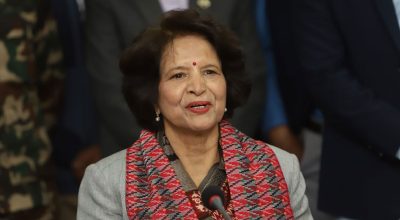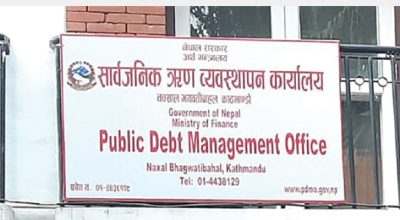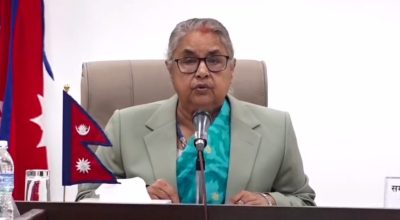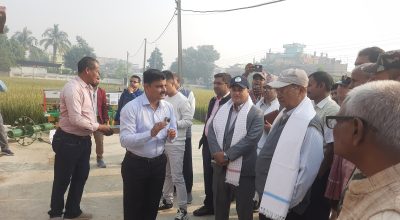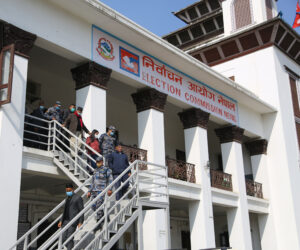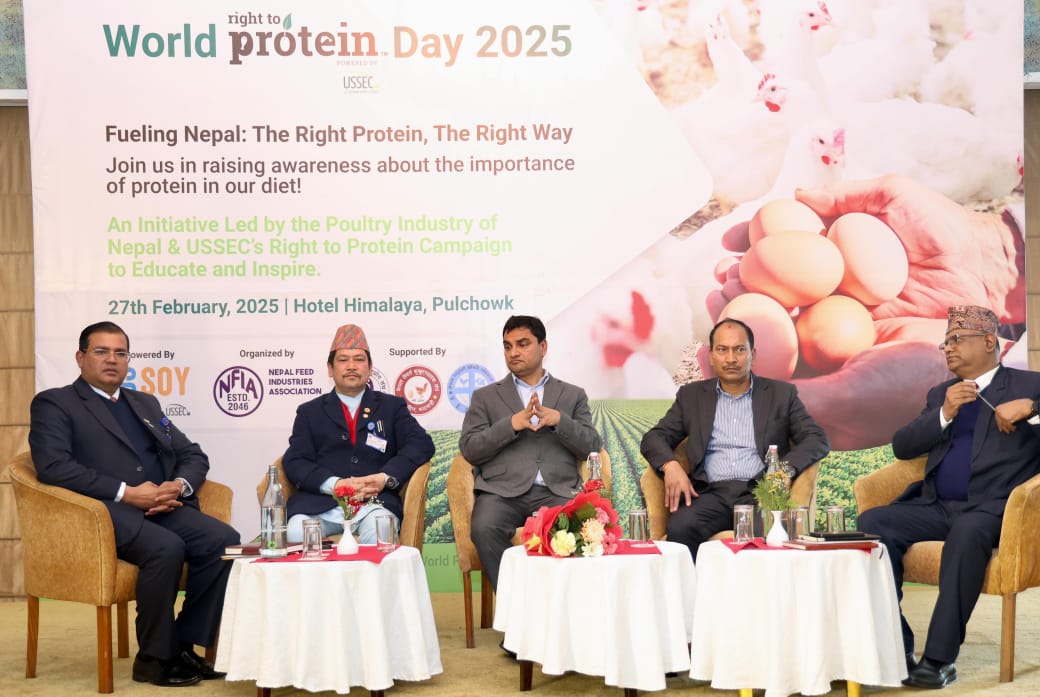
Kathmandu, Mar 2: Nepal on February 27 marked the world protein day 2025 under the theme “Fueling Nepal: the right protein, the right way”.
In a program organized by Nepal Feed Industries Association along with Nepal Layers Farmers’ Association, Nepal Hatchery Association and Nepal Veterinary Chemist and Druggist Association two thematic papers were presented by Dr. Ashesh Bhattarai, team lead USSEC Nepal and Ms Rashmi Bajimaya Shrestha from Nepal Dietitian Association.
Dr. Bhattarai cleared all the myths and facts about chicken and eggs in the market, which are dominant domain under animal protein in Nepal. Chicken and eggs are considered to be one of the best and cheapest sources of protein. He said that nowhere in the country growth hormones are used for the production of chicken as their use are very irrationals and is not even relevant.
Similarly, he said that since the country has adopted no antibiotic use policy in animal feed there is almost no chances of having antimicrobial residue in chicken meat from feed. Besides, he said that like in human, on need basis, medications including the antibiotics will certainly be used during their lifespan and should always be done under the prescription or supervision of registered veterinarian. He said that as per the government official data on antibiotic residue in chicken meat there are very negligible cases crossing the maximum residue levels (MRLs).
He opined that chicken and eggs can be considered as one of the best sources of protein for the body as has been proved scientifically. He also said that eggs help increase HDL (high density lipoprotein, the “good” cholesterol, which is beneficial for heart health. He said that the thumb rule for protein requirement is one gm per kg body weight per day for an average adult and varies slightly as per age, and the daily routine that the human being perform.
Rashmi Bajimaya Shrestha detailed out the calculation of protein in our daily diet with a proper diet plan for people from various walk of life including the diabetic patient. She also clarified myths related to proteinous food. She said that there is a myth that proteinous food derails wound healing process. She said that protein is crucial part of our nutrition and we should include their sources in all course of meal.
She also highlighted on the nutritive value of various common food that we eat in Nepal along with recommended dietary allowances for normal adult and during other physiological stages like pregnancy, during lactating stage etc.
Dr. Umesh Dahal, Director General from Department of Livestock Services, Mr. Sanjeev Kumar Karn, Director General from Department of Food Technology and Quality Control and Dr. Prakash Budhathoky, spokesperson from Ministry of Health and Population had their view as panelists during the technical session which was moderated by Dr. Surendra Karki from FAO of the United Nations.
Dr. Umesh Dahal said that livestock industry has made the country self-sufficient in meat, milk and eggs which also means that the industry is supplying protein as nutrition to the consumers through those commodities.
Sanjeev Kumar Karn said that its time to consider whether we are consuming the right protein or not as the country is sufficient in animal based protein. He said that we should also be aware on various anti nutritional factor along with protein consumption. He said that public should be disseminated about protein intake in household unit like in a cup, in a glass etc rather than in scientific SI units. He also differentiated between unsafe food and low quality food. He reiterated that media should rather disseminate scientific message in layman style, with precautions not to mislead the message. He also said that his department’s primary role is to regulate the food products in the market and the role for safety and quality should be played by the private sector and service providers in the country.
Chief guest Mr. Pradip Paudel, Minister, Ministry of Health and Population, during his guest remarks highlighted on importance of animal protein in human nutrition. He also reiterated on the role played by Ministry of Health in reducing the malnutrition in Nepal by focusing on protein intake in the balanced diet. He said that ministry will definitely chalk out in developing the protein related guidelines, if needed. He also said that the established role, to be played by medical personnel, related to protein can be further discussed in official platform.
The program which was powered by United States Soybean Export Council (USSEC) under right to protein initiative in Nepal was chaired by Mr. Rabin Puri, President of Nepal Feed Industries Association.
Around 160 participants were present from different hospitals in the valley. Physicians, dieticians, veterinarians, poultry entrepreneurs, policy leaders were present in the program





